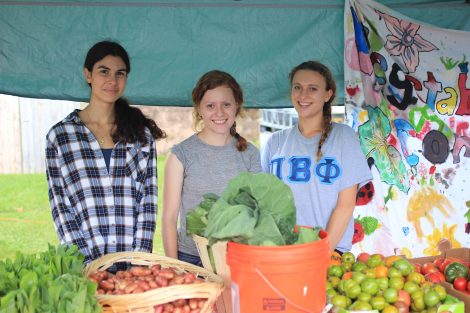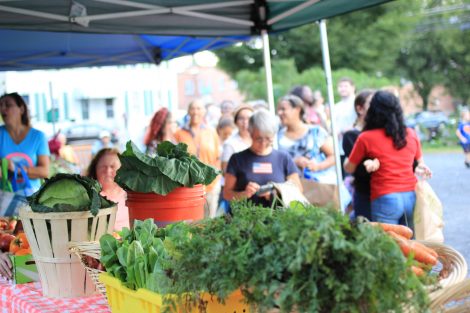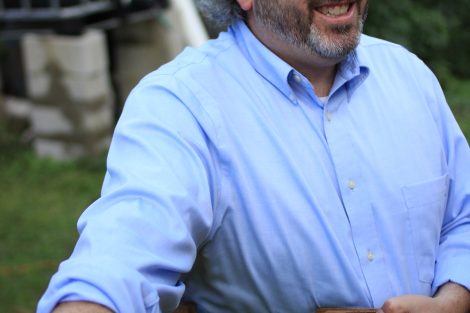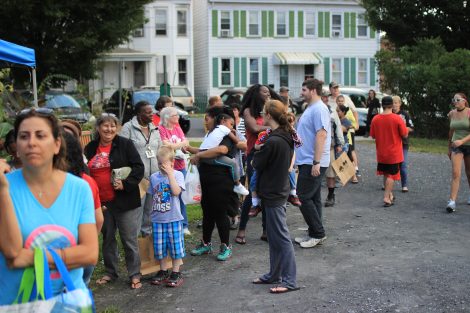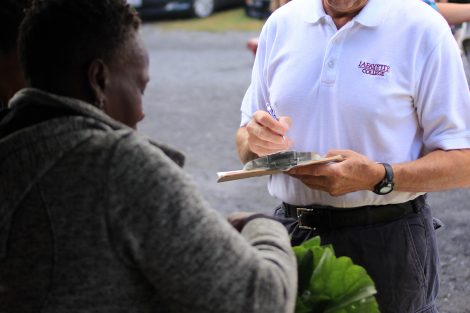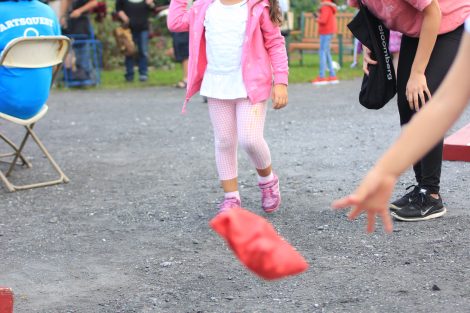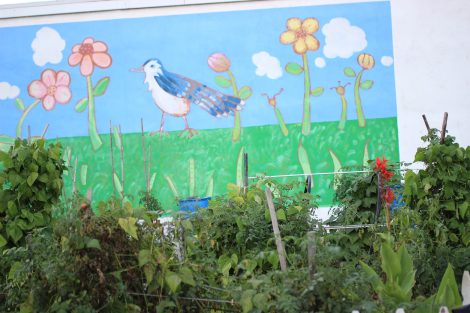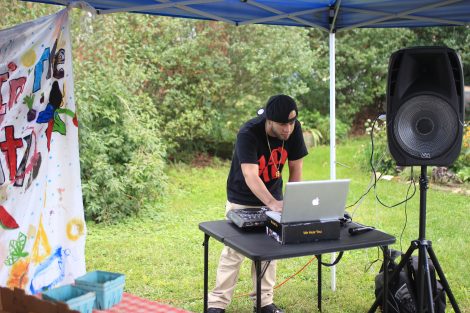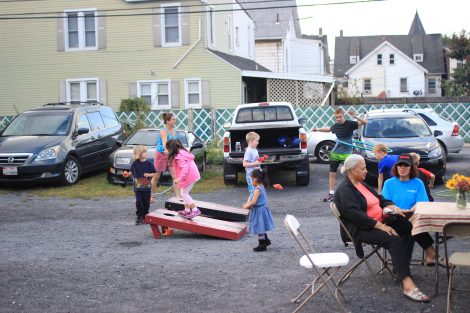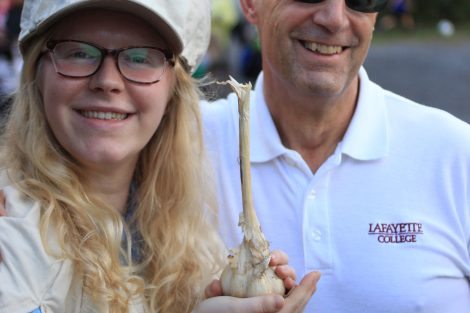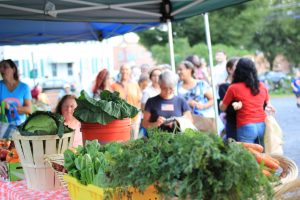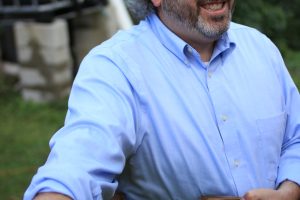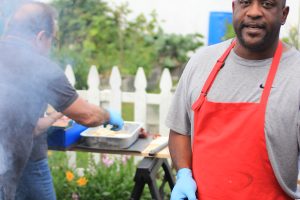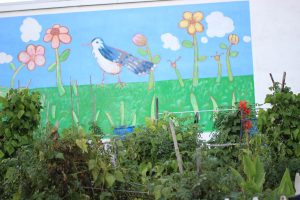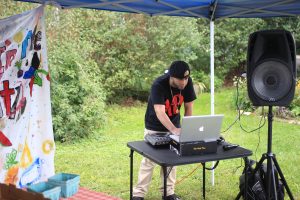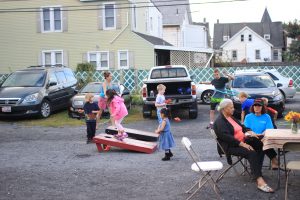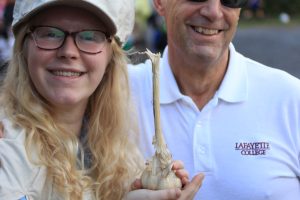Story and photos by Stephen Wilson
Hip hop pumps from two speakers, and the smoke from a large grill fills a gravel parking lot in Easton’s West Ward. Neighbors chat while their kids kick a soccer ball or toss bean bags. What sounds like a block party is more than that. Much more.
All are gathered to celebrate the final night of Vegetables in the Community, a food distribution stand that started as a solution from a Technology Clinic class working with Sophia Feller and the now dissolved West Ward Neighborhood Partnership to address a local food desert. But this veggie stand has grown into a community development project.
Under four tents are bushels of produce. According to Casey Banta-Ryan ’20 (Acton, Mass.), five tons of produce were distributed this summer. She is focused on the economic aspects of this year’s yield. “Over the four years, we have distributed 100,000 servings of veggies,” she says. “The nutritional value of that amount of product totals $75,000.”
This year has been bountiful, thanks in part to the perfect balance of rain and sun. People in line select from garlic, a variety of tomatoes, carrots, corn, eggplant, a variety of greens, and onion, which have come from many contributors. The LaFarm garden is but one of the gardens across Easton, along with ones cultivated by community partners like Safe Harbor, Lynn St. Community Garden, Crayola, and Easton Urban Farm.
A bonus this year is fruit. Bechdolt Orchard in Hellertown has donated peaches, apples, and pears, thanks to a volunteer who made the connection.
Jen Giovanniello ’20 (Morganville, N.J.) has managed the labor dynamics, tracking hours worked and volunteer assistance. “We always need help,” she says. “It gets easier to find it when the students return, so we can count on our orientation students and EcoReps. But our goal is to increase the number of community members at the farms.”
The community is here, residents snaking through the tents and waiting for a chance to fill their bags.
“Each week we have a consistent group of 60-80 families at the stand. Probably 40-50 are there every time and about 20 or 30 are new each week,” says Benjamin Cohen, associate professor of engineering studies. “But it has taken several years for us to create a community.”
He describes how more neighbors come early, help set up, and make signs. They share food knowledge, bring recipe cards, and cook samples.
“It has become a place to gather and build relationships,” Cohen says. “We have people of various means and backgrounds, from lawyers to those in need. All share in the bounty and contribute what they can.”
A simple donation bucket sits at the end of the table. Donations have been up this year, totaling almost $120 a day. According to Casey, the average donation per person has doubled from $1 to $2.
It’s not enough to fund the stand, but support over the years has come from the College, City of Easton, and Easton Hospital.
While funds are important, that’s not the goal. Those are loftier.
Neighbors make connections. A bounty is shared. Families eat better. A food desert is eliminated. Citizens rely less on city services. Students learn. Knowledge is exchanged.
“Many people are surprised when we talk about the labor involved in our gardens,” Cohen says. “They think we plant and wait until harvest. They don’t consider planning, starting seeds, seed allocation, soil preparation, planting, watering, weeding, pest management, labor monitoring, equipment maintenance, weather concerns, harvest, delivery, set-up, and donations.”
Much of that work was in hands of Andie Mitchell ’18 (Bainbridge Island, Wash.). She along with Giovanniello and Banta-Ryan sweated, swatted, and served as the ambassadors all summer. Long hours over long days.
“It is so much more than standing at 10th and Pine Streets for an hour and a half for 12 weeks,” Mitchell says.
That’s where you find Lawrence Malinconico, professor of geology and director of the Technology Clinic. At the end of the line, holding a clipboard and pen, he gathers the tracking data needed from each person. His Tech Clinic team conceived of this solution five years ago.
“The first delivery had me and a student parked at the Easton Area Community Center with veggies in the back of my pick-up,” he says. “It was chaos as people descended on the truck. We moved here the next week and have been here since.”
He surveys the line of people and smiles as he watches the teamwork and comradery. Add to it the beat of the music, the colorful produce, and the off-the-grill smells.
“This is what makes it all worthwhile,” Malinconico says.
